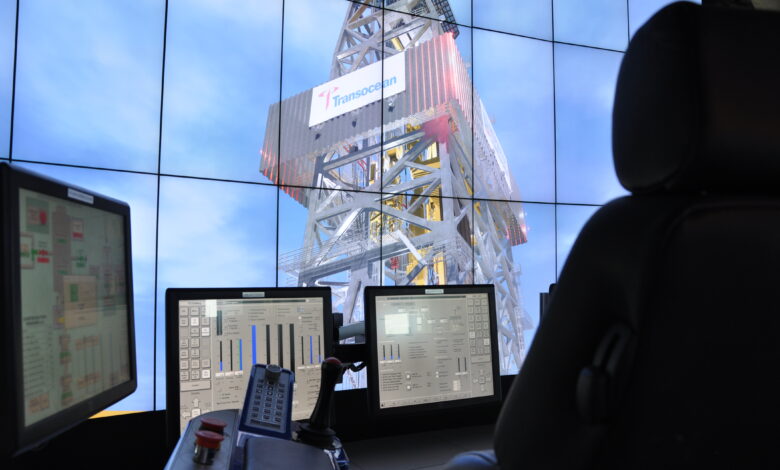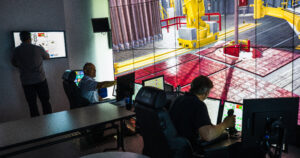Industry leverages automation, digitalization to build a better and safer work environment


By Jeremy Thigpen, 2022 IADC Chairman
A career in offshore drilling has always presented a wide range of interesting and exciting opportunities, but working offshore has never been more promising than it is today. As our industry adopts innovative technologies, increases automation and digitalization, and embraces augmented learning, the work on our rigs has changed, requiring a modified workforce with different skills and experience. And, with the recovery of commodity prices, strong and increasing demand for energy, and the growing realization that oil and gas will continue to represent a critical component of the global energy mix for the next several decades, there has never been a more opportune time for smart, creative, committed and ambitious individuals to join the drilling industry.
While working offshore typically requires spending weeks away from family and friends, many find a secondary family atmosphere offshore. Perhaps more importantly, the compensation for our offshore crews is typically very compelling. Additionally, because of our rotational approach, our crew members have abundant free time to spend wherever they may call home, or traveling, or pursuing their passions and hobbies. And, for those who prefer not to rotate offshore, there are numerous opportunities onshore, as well.
When thinking about a career, it’s important to know that you can operate in a safe, evolving and exciting environment. So, I’ll start with some of the ways our industry is continuing to improve safety, given that is the foundation for our industry’s success. I’ll then discuss our efforts to develop the crews of the future and how processes, including how we learn within our industry, are changing.
On the safety front, we are constantly looking for ways to deploy technologies that help keep our crews safe. At Transocean, we have developed and deployed our patented HaloGuard system, which sounds a series of alarms when members of our crew are in close proximity to a moving piece of equipment on the drill floor. If required, the system will halt equipment to prevent injury to personnel who move too close.
Later this year, we expect to be the first offshore driller to deploy robotic riser bolting tools on a few of our ultra-deepwater drillships operating in the Gulf of Mexico. We are currently piloting these tools onboard one of our drillships, and early returns are promising. The robotic riser system automates all activities around the rotary table during riser operations, improving personnel safety by eliminating the need for work in restricted-access areas, while simultaneously improving consistency and increasing efficiency of operations.

It is natural to hear the word “automation” and wonder what that may mean for future employment opportunities. From my perspective, automation improves safety and actually opens the door for more opportunities – not fewer. Years ago, to get a job offshore, a person would have to pick up two 50-lb bags, hoist the bags above the person’s head and then ascend a set of stairs. The world has changed. Opportunities on offshore drilling rigs no longer require this type of brute strength, but instead rely on the technical astuteness of the rigs’ crews. As an example, the role of an electronic technician on a drilling rig is now more akin to an information technology job onshore.
To adjust to increased digitalization and automation on our rigs, Transocean brought in an ergonomist – a person who studies, designs and evaluates human work systems – to evaluate and reconfigure the physical requirements of our offshore positions to be more aligned with the new way we work. And as roles on our rigs evolve technically, we have had our job descriptions reviewed by experts to match for competencies that could be measured through pre-employment online assessments. The assessments focus on technical and behavioral competencies predictive of job success. Our candidate pools are now larger, more diverse, and include individuals who offer key competencies, along with broader skill sets and knowledge.
And the best news for those who are already part of our industry, and those who may become a part of it in the future, is that we have a myriad of new ways to learn how to apply these new technologies and to enhance the processes we rely on daily to safely complete our operations. For instance, at Transocean’s Houston office, we have state-of-the-art simulators that provide our employees hands-on experience with advanced offshore and marine technology. This immersive environment allows employees to learn how to best respond to high-stress critical operations and to hone their skills in a highly realistic but safe and controlled environment. This equipment allows crews to gain experience and practice decision making in a variety of scenarios and then evaluate the results as a team. The importance of being able to learn from mistakes in this environment cannot be overstated.
What is possible today through digitalization is enhanced by high-speed data connections between the rig and shore-based operations centers. On a few of our rigs operating in Norway, we use remote operated vehicles (ROVs) – essentially underwater robots – operated by ROV technicians who are potentially hundreds of miles away from the rig. We have also piloted running other equipment, such as cement units, remotely with great success.
Among the benefits of these advances is that subject matter experts for highly technical operations no longer need to be flown to the rig to do their job. Additionally, key information used in the well construction process – such as downhole drilling data – can be sent onshore for real-time analysis and action. This allows actual conditions at the drill bit to be compared with a baseline digital twin of the well, so adjustments can be made to enhance drilling performance, rate of penetration and, ultimately, the overall safety of the process, while eliminating nonproductive time.
As we move toward a more fully digitalized future, we are also using technology to enhance the resources and job aids our crews can access offshore. A tablet can help a crew member reference a procedure or checklist at the worksite. Tablets also offer the ability to capture lessons learned in real time. For example, a photograph can be taken of an issue or concern and updated on the spot. This allows us to identify issues and concerns more quickly and share them across our fleet.
Another digital platform we have introduced allows us to identify gaps in company requirements and to share corporate learnings with a focus on improvement. We can identify gaps from rig to rig and determine whether an issue is isolated, if we need to amend our policies and procedures companywide, or perhaps provide more training to our crews. Digitalization provides us with valuable insights into what our crews are seeing on our rigs and throughout their tasks, and promulgate this information fleetwide. Proactive monitoring and management increases efficiency and safety.
All this highlights the importance of hiring the right individuals to work on our rigs. We look for individuals who approach work with focus, discipline and structure, and who understand the criticality of following established policies and procedures. Our rigs are complicated and heavy industrial worksites, and the potential for injury is real. We have policies and procedures, and each task is planned out for important reasons – key among these are the safety of our crew and the efficiency of our operations.
Digitalization is also helping to improve uptime. As another recent example, some equipment was inoperable on one of our rigs in Norway. The rig crew was advised that it would take nearly 30 hours to get the equipment fixed because the manufacturer’s representative was unable to travel to the rig until the next day. Our shore-based team learned of the issue and discussed it with the provider, suggesting the manufacturer could remotely log into the piece of equipment and pinpoint the issue. As a result, the problem was identified and solved within a few hours. The flexibility that digitalization offers and the ability to monitor equipment and make important adjustments and corrections quickly is a huge step forward for our entire industry.
This underscores why technical astuteness is an attribute we seek at Transocean and across our industry, as we assemble the crews of the future with a focus on continual competency, by taking lessons learned and implementing mini-training elements to address issues as they arise.
The offshore drilling business is changing in exciting ways, and the future is bright for those who are perpetual learners interested in augmented learning and digitalization. I’m excited for what’s ahead for our industry and know we are just scratching the surface of what’s possible as we continuously advance as technical leaders, and relentlessly pursue improvement in all that we do. The drilling industry is a terrific place for smart, ambitious people who understand the value our industry creates in the world. Come join us. DC




